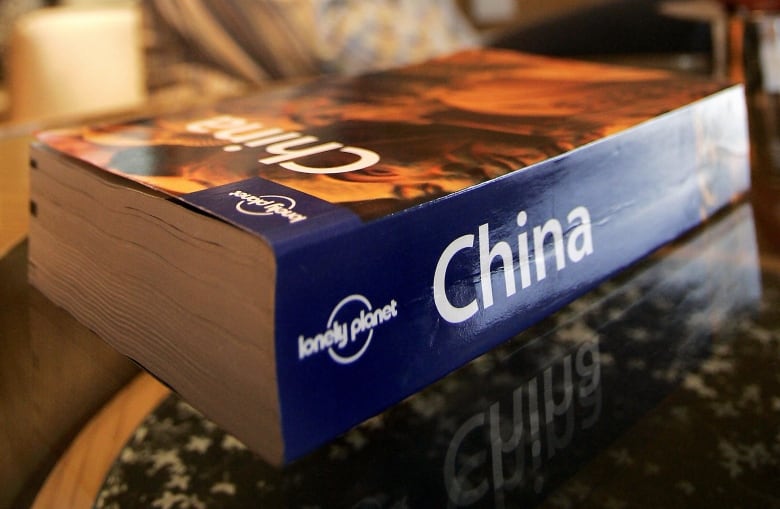The Current24:1550 years of the ‘backpacker’s bible’
For 22 years, Nicole Thorpe has been what she describes a “global nomad,” travelling to and working in as many as 50 countries in total.
Throughout her trips, she’s always carried a Lonely Planet guidebook.
“It is my bible, and I have kept them all, full of notes and memories,” said the Nanoose Bay, B.C., resident.
“Even now the first thing I do when my husband and I start thinking about our next trip is buy the Lonely Planet [guidebook],” she told The Current in an email.
This year marks 50 years since the first Lonely Planet book, Across Asia on the Cheap, was published. Lonely Planet was co-founded by married couple Tony and Maureen Wheeler after they embarked on an overland trip through Europe and Asia to Australia.
Since then, they’ve published hundreds of the guidebooks, covering destinations on every continent. Now owned by Red Ventures media company, the company has also launched a website, an app and a YouTube channel, among other properties.

Tony Wheeler said the initial guidebooks were aimed at young, penniless backpackers like himself and his wife.
“We thought this is the sort of thing we would like to have had, and that turned out to be a pretty accurate decision,” he told The Current‘s Matt Galloway. “But, you know, pretty soon we began to cover more places — and not just for backpackers.”
“So although Lonely Planet is always going to have that reputation as being the backpacker’s bible sort of thing, it soon became much more than that.”
From Europe to Asia and onto Australia
When the couple set out on their cross-Europe and Asia trip in 1972, they didn’t do it with the intention of publishing a book from it.
“We’ve been married for less than a year, we were both in our early 20s … living in London at the time, and we decided to take a year off and get travel out of our system,” he said.
“We bought an old car in London and we thought we’ll just drive it as far east as it goes.”

That “cheap” car took them across the European continent and a large chunk of Asia. They drove through Turkey and Iran, all the way to Afghanistan, where they sold it for a small profit in Kabul.
But even without the car, the couple carried on until they got to Australia — where the British nationals set up camp for a while.
“During that year that we lived in Sydney, in Australia, so many people asked us about the trip we’d just done that we thought someone should write a book about it, and that’s what happened,” he said.
“I’ve always been a bit of a note taker and diary keeper, so I did have some notes and we had the information that we had collected before we started and gleaned along the way.”
When they released the first Lonely Planet guidebook, Wheeler said they initially “did it for ourselves” and weren’t sure how much of an audience there was for the guidebooks. But as it turned out, it attracted a lot of interest from fellow travellers.
“50 years ago, when these first guides came out … there were a lot of other boomers who were going out there and they were going further than their parents did,” he said.
“If their parents sort of went through Europe, well, they went on to North Africa … [or] they got out on the hippie trail, as we did, across Asia or in North America.”
On The Coast6:19Are social media travel influencers ruining places that were once special to locals?
Revealing interesting places
Although Lonely Planet received reactions that they were filling a gap in the market, they were also accused of ruining secret places by revealing them and making them more popular.
“The accusation that we’d ruined places first started popping up with Bali,” Wheeler said. People would say, he recalled, “‘Oh, we remember Bali when it was quiet and unspoilt and there were no paved roads and just sandy tracks leading down to the beach,’ as if we’d put the road in.
“We didn’t do that. We were a small factor among many others. We didn’t start putting in all the flights and building the international hotels.”
Still, Wheeler is aware of the “ongoing argument” between revealing interesting, off-the-path travel places and creating issues in local communities.
“One of the things about guidebook writers is the job is to reveal the interesting places,” he said. “If it’s a great discovery and nobody else has been there except for the locals who keep it to themselves, what do you want to do? You want to reveal it to the world.”
“But, you know, we are also very aware of the the dangers of overtourism.”

Among the places included in Lonely Planet guidebooks is a small village north of the Algarve, Portugal, where the best cataplana — a Portuguese fish stew — could be eaten.
Kathleen Elias and her first husband travelled to the village in 1999 on a tip from the Lonely Planet guidebooks. There, they found locals crowded on picnic tables around a big, homestyle pot filled with cataplana.
“I’m sure the locals had no idea how we had found it, and they kept staring and I’m sure talking about us,” she told The Current via email.
“However, they were very friendly and happy to share their meal with us once they saw that we too were enjoying the best cataplana ever.”
Wheeler said he’s always appreciative of hearing how the Lonely Planet has changed the lives of travellers.
“I love it when people say, ‘I was pretty adventurous anyway, I’d have gone to these places, but you sort of opened the door a little bit and then you just gave me a little bit of a shove,’” he said.
